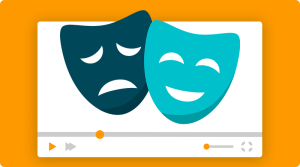How to create inclusive corporate videos for global audiences
Written by Jesse Galanis | 15th October 2025

Table of Contents
Global companies often face a tough task: getting messages across cultures and languages without confusion. Corporate videos, when made inclusive, can bridge that gap and maintain clear and simple communication.
When companies prioritize inclusivity in video, they also signal respect for their diverse teams. The result is stronger engagement and better understanding, creating a workforce that is connected to shared goals.
This page tackles the importance of inclusivity for corporate videos. Read on to learn how to create an inclusive clip for global audiences.

Why inclusivity matters for corporate videos
Did you know that over 90% of businesses use video as a marketing tool? This form of content has the power to attract, engage, and convert prospects into customers. However, to make it work for your business, you must make it as inclusive as possible.
Inclusive corporate videos are built with intention. They welcome people of all backgrounds, abilities, and cultures. These clips often consist of the following core principles:
- Cultural awareness: Honor local customs and nuances while still building common ground.
- Language accessibility: Keep wording crisp, with subtitles and localization that preserve the tone.
- Visual and audio accessibility: Use strong contrast, legible fonts, clear audio, and descriptions so no one’s left out.
- Unbiased representation: Spotlight authentic, diverse people without clichés or cultural shortcuts.
- Balance global and local relevance: Blend universal themes with local flavor to make messages resonate.
When done correctly, they’re accessible, culturally aware, and relevant to a global workforce. Ultimately, they help build connections among all stakeholders involved. Even one inclusive video can replace three sales calls for conversion.
Across business functions, inclusivity pays off. Training becomes easier to absorb, leadership messages land across borders, and team engagement rises when employees feel seen and valued.
Without it, the risks are real. Language gaps, cultural missteps, or lack of accessibility can alienate viewers and weaken communication. Inclusive videos turn those barriers into bridges, making sure everyone connects with the message.

Key steps to create inclusive corporate videos
Did you know? Nearly 14% of marketers invest more in video marketing this year. Why? Among all forms of content, videos connect well with people, no matter where they are in the world. However, the challenge lies in how these clips would resonate with a global audience. Inclusivity is key!
Creating videos for global audiences takes more than translation. Whether it’s interactive training videos or promotional clips, it’s about creating content that feels natural, respectful, and relatable, no matter where it’s viewed.
With a few practical steps in place, you can ensure your videos connect across cultures. These will avoid common pitfalls that limit reach. Follow the crucial steps below.

1. Plan with inclusivity in mind
Before you start scripting or designing, think about inclusivity from the ground up. A thoughtful plan helps ensure your videos resonate across cultures, rather than feeling one-size-fits-all.
- Define global audience personas: Map out who you’re speaking to and their needs. Sales training may shift with local traditions, while onboarding should mirror diverse backgrounds.
- Research with stakeholders: Talk with regional partners and dig into local habits, cues, and pitfalls to see what connects or alienates different audiences.
- Build a diverse team: Bring in voices from varied regions and roles so their perspectives shape authentic scripts and design choices.
- Align goals with audience needs: Tie your video’s purpose to audience diversity, keeping messages clear, relevant, and respectful of local context.
Leigh McKenzie, Community Advocate at Traffic Think Tank, highlights the value of inclusivity in business. He claims that it’s key to expanding your reach and engaging diverse audiences. He believes that being inclusive compels people to patronize your business.
McKenzie says, “Inclusivity drives reach and relevance. When people feel represented, they’re more likely to connect with your message and choose your business. Whether it’s a blog post or video content, being inclusive is a good practice and a perfect growth strategy.”

2. Script and storyboard for global appeal
Your script and storyboard set the foundation for how your message lands across cultures. To connect globally, keep your language clear, your stories universal, and your visuals inclusive.
- Write in plain, clear language. Keep scripts simple and easy to translate. Skip idioms, culture-bound humor, and wordy lines that slow viewers down.
- Tell universal stories. There’s psychology behind storytelling in videos. Use relatable themes like shared challenges and workplace wins so your message resonates across cultures.
- Use inclusive visuals and metaphors. Stick to clear, diverse imagery and avoid symbols or stereotypes that don’t travel well.
- Collaborate with regional teams. Let local teams review scripts and storyboards to catch cultural blind spots and suggest tweaks.
- Leverage templates for consistency. They enable you to generate and personalize clips for diverse audiences. Take simpleshow’s customizable illustration for modern videos, for instance. It has features like expanded color options, customizable backgrounds, and smooth scene transitions, allowing you to easily and quickly create videos.

3. Produce with design, voiceover, and localization in mind
Creating a video that resonates worldwide requires planning for global impact from the outset. Every design choice, voiceover decision, and localization step plays a role in how your message is received across cultures. Being intentional early on can help you save time later while ensuring your content feels inclusive and professional everywhere.
- Design with global resonance. Choose visuals, colors, and symbols that feel universal. This keeps imagery professional and culture-neutral unless tailoring for a local version.
- Plan flexible voiceover options. Decide if a neutral accent, multilingual tracks, or subtitles work best. Doing so helps balance reach, budget, and goals.
- Use AI for speed and consistency. Tools like simpleshow AI streamline translation, voice cloning, and accessibility while keeping quality high.
- Test for cultural accuracy. Share drafts with regional focus groups to flag blind spots, clunky phrasing, and accessibility gaps early.
- Simplify localization with templates. simpleshow’s versioning tools keep design consistent while fine-tuning language and examples for each audience.
Anna Zhang, Head of Marketing at U7BUY, suggests producing video content with three key elements in mind. She cited design, voiceover, and localization as crucial factors for establishing inclusivity.
Their company also creates a fair share of videos for online gaming, attracting people of all ages and from all walks of life. See their TikTok clip representing an Asian online gamer:
Zhang explains, “When producing videos for a global audience, design, voiceover, and localization are essentials. Each decision shapes how your message lands across cultures and languages. Getting these right not only avoids missteps but also builds trust and credibility worldwide.”

4. Ensure accessibility and compliance
Making your videos accessible isn’t just about meeting legal standards. It’s about making sure everyone can engage with your content. Following international guidelines and using the right tools helps create videos that are both compliant and genuinely inclusive.
- Meet international standards. Follow Web Content Accessibility Guidelines (WCAG), the Americans with Disabilities Act (ADA), and other guidelines to stay compliant and show real commitment to inclusivity.
- Add captions, transcripts, and audio descriptions. These essentials make content precise and accessible, especially for HR, training, or compliance needs.
- Review legal and ethical requirements. Check local laws and cultural norms to avoid regulatory slip-ups or cultural pushback.
- Use accessibility-ready tools. Platforms like simpleshow simplify compliance while keeping videos engaging and audience-friendly.

5. Set metrics, measure and improve
Creating inclusive videos doesn’t stop at production, as it’s an ongoing process. Measuring results and gathering feedback help you understand what’s working, spot gaps, and refine your strategy for stronger impact over time.
- Define KPIs upfront. Track engagement, comprehension, and feedback early to see if inclusivity efforts are landing and where to fine-tune.
- Gather feedback from diverse audiences. Input from global teams reveals cultural nuances and unmet needs, giving you a fuller picture.
- Iterate regularly. Refresh and review content often so your video strategy stays sharp and relevant as teams and contexts evolve.
Eric Do Couto, Head of Marketing at Visualping, recommends measuring and optimizing video content for maximum impact. He believes that this ongoing process helps ensure you create inclusive videos that resonate with a wide range of diverse audiences.
Take a glimpse of their video that thrives on inclusivity and connects with people:
Do Couto shares, “Measuring video performance isn’t a one-time exercise but a cycle. Tracking engagement, collecting feedback, and adjusting content keep inclusivity at the core of your content strategy. The more you refine, the more your videos resonate, and the more trust you earn across cultures.”

Empowering global teams through inclusive videos
Inclusive videos help global organizations connect better by removing communication barriers and making every employee feel part of the conversation. They improve engagement, comprehension, and belonging across diverse teams.
Beyond training, inclusive videos enrich company updates, policy rollouts, and even cultural celebrations. Each video presents an opportunity to reinforce the values of respect, equity, and collaboration.
Ready to create an inclusive corporate video? Let simpleshow guide you every step of the way. Request a demo today and discover how inclusive communication can enhance your team’s performance.
Author's bio
Jesse Galanis is a professional writer who decomposes complex concepts of business information and working online. He provides quality content that assists people in everyday life.


